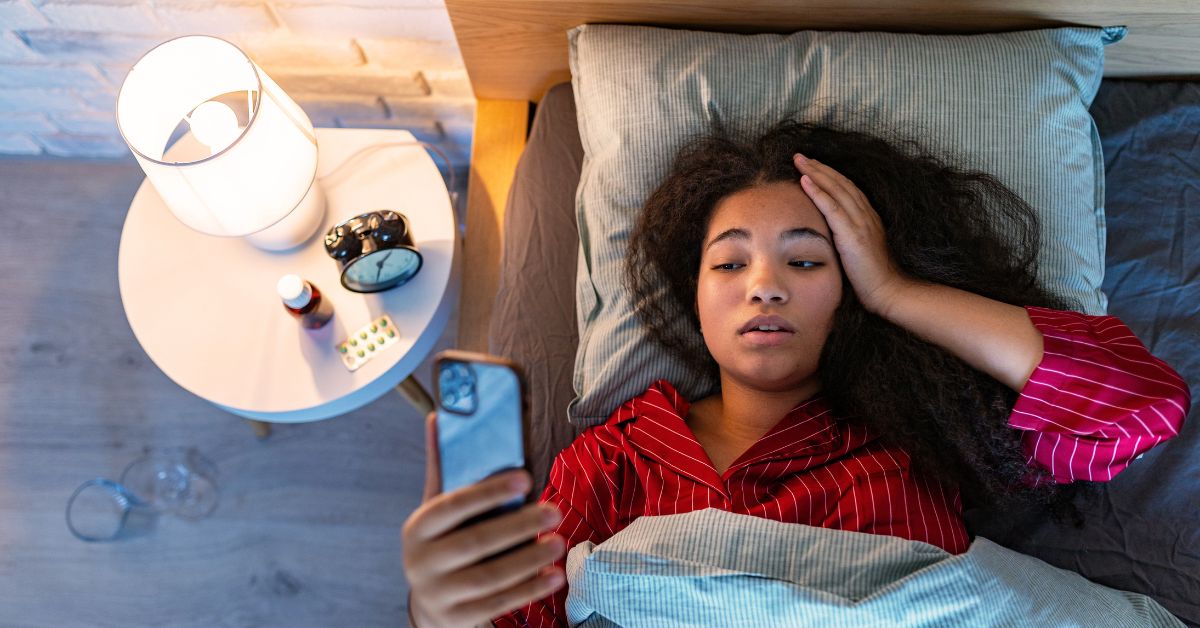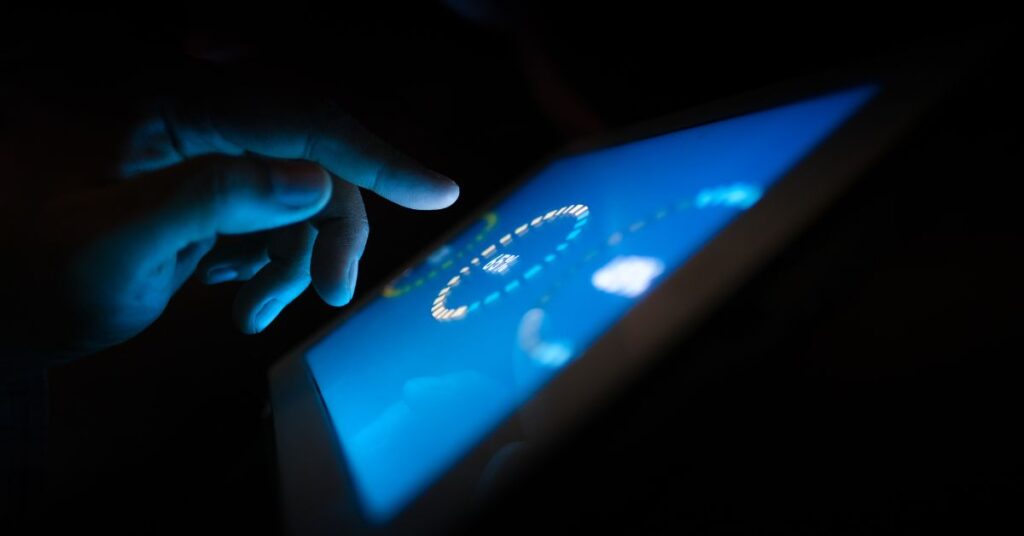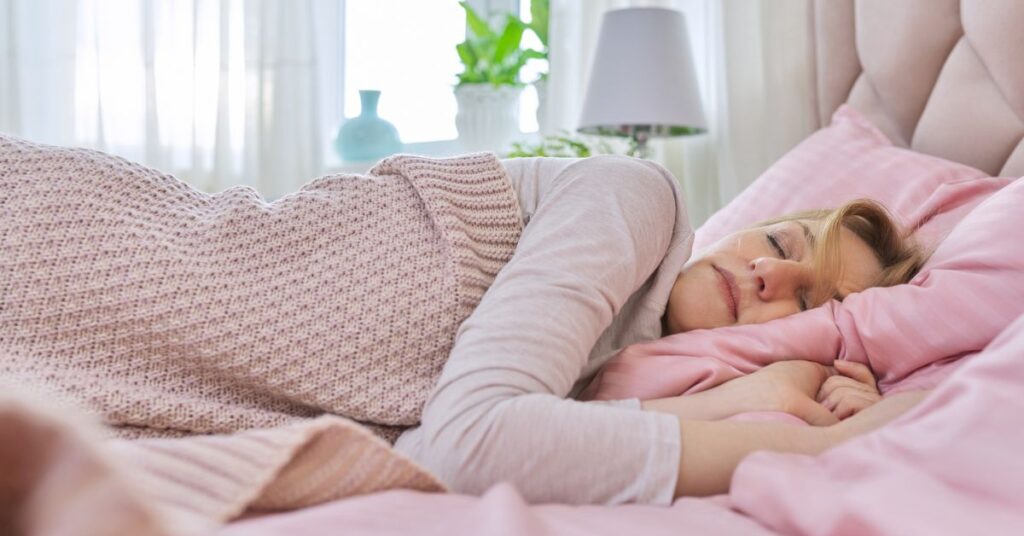Screen Time Personality Quiz
Discover Your Pathway to Digital Peace.
TAKE THE QUIZ
Guide to
Grayscale
MAKE YOUR PHONE LESS ADDICTIVE IN SECONDS.
DOWNLOAD
DOWNLOAD
Your screen can become a tool for encouragement.
Wallpapers for Desktop & Phone
Hey, I’m Julianne!
Christian Coach, encourager, digital distraction disruptor. I help people reduce their screen time, build life-giving habits, and stay focused on what matters most. The digital world isn’t going away, but your distraction can. So glad you’re here!
Welcome!

TELL ME MORE
Block Distracting Apps With One Quick Tap
Meet The Brick
July 29, 2025
27 | Having Trouble Sleeping? The Blue Light Truth About Evening Screen Time Every Tired Person Needs to Know
The Invisible Light Stealing Your Sleep Every Night
You crawl into bed exhausted, but the moment your head hits the pillow, your mind starts racing.
Twenty minutes pass. Then forty. You toss, you turn, you check the clock again, and frustration builds because you know you need sleep, but it feels completely out of reach.
Here’s what you might not realize: that innocent “quick scroll” through social media before bed, the evening emails you answered, or even watching Netflix until 10 PM could be sabotaging your sleep in ways you never imagined.
The culprit isn’t just screen time—it’s the specific type of light your devices emit, and how blue light affects sleep quality in profound ways.
If mornings feel like climbing out of quicksand, if you reach for caffeine like a lifeline, or if you’ve wondered why sleep feels more like a battle than a blessing, understanding how blue light affects sleep quality might be the missing piece you’ve been searching for.
Understanding what’s happening in your brain when blue light hits your eyes after sunset, and how small changes can transform both your nights and your mornings is a game changer!
What Exactly Is Blue Light and Why Does It Matter?
Blue light is a specific wavelength of light (around 400-500 nanometers) that’s naturally abundant in sunlight. During the day, blue light is actually beneficial as it boosts alertness, elevates mood, and helps regulate your circadian rhythm.
But here’s where it gets problematic: every screen in your home emits blue light. Your smartphone, tablet, laptop, television, and even LED light bulbs all produce this alertness-triggering wavelength.
When blue light affects sleep quality, it’s because your brain interprets this light as a daytime signal, even at 9 PM.
God designed our bodies with an intricate internal clock that responds to light and darkness. For thousands of years, humans lived by natural light patterns, bright during the day, dark at night. Our circadian rhythms evolved to release specific hormones based on these light cues.
But in just the last two decades, we’ve completely disrupted this divine design with artificial light exposure in the evening hours.

The Science Behind How Blue Light Affects Sleep Quality
Your Melatonin Gets Hijacked
When blue light hits special cells in your retina called intrinsically photosensitive retinal ganglion cells, they send a direct signal to your brain’s master clock. This signal says, “It’s daytime! Stay alert!”
Melatonin isn’t just a sleep hormone, it’s your body’s natural signal that it’s time to wind down, repair, and restore. Multiple controlled studies show screen use before bed suppresses melatonin, pushes sleep onset later, and reduces morning alertness.
Dr. Charles Czeisler’s research team found that blue light suppressed melatonin for about twice as long as the green light and shifted circadian rhythms by twice as much (3 hours vs. 1.5 hours). That means your 10 PM intention to fall asleep becomes a 1 AM reality.
Your Circadian Rhythm Gets Confused
Your circadian rhythm is like a master conductor orchestrating dozens of biological processes—hormone release, body temperature, blood pressure, and cellular repair. When blue light affects sleep quality by disrupting this rhythm, the effects cascade throughout your entire system including less deep sleep, more time to fall asleep, significantly higher cortisol levels the next morning and reduced cognitive performance for up to 48 hours.
Your Brain Gets Stuck in “Daytime Mode”
Blue light exposure activates your sympathetic nervous system which is your “fight or flight” response. Instead of transitioning into the parasympathetic “rest and digest” mode your body needs for sleep, you’re essentially telling your brain to stay vigilant.
This is why you can feel physically tired but mentally wired after evening screen time. Your body knows it needs rest, but your brain is receiving contradictory signals.
How Blue Light Affects Sleep Quality Throughout the Night
The impact of blue light doesn’t end when you finally fall asleep. Research shows it affects multiple aspects of sleep architecture:
Sleep Onset Latency: How long it takes you to fall asleep increases by an average of 10-15 minutes after blue light exposure.
REM Sleep Quality: Blue light exposure reduces REM sleep by up to 23%. REM sleep is crucial for memory consolidation, emotional processing, and mental restoration.
Deep Sleep Duration: The restorative slow-wave sleep phase gets shortened, meaning your body has less time for physical repair and hormone regulation.
Sleep Fragmentation: People exposed to evening blue light wake up more frequently throughout the night, even if they don’t remember these awakenings.
Morning Grogginess: The sleep debt created by poor quality rest compounds, making mornings feel increasingly difficult.

The Hidden Cost of Blue Light Sleep Disruption
When blue light affects sleep quality night after night, the consequences extend far beyond feeling tired:
Spiritually: Poor sleep clouds our ability to discern God’s voice, pray with focus, and respond to His leading with wisdom rather than reactivity. We become more vulnerable to spiritual attack when we’re running on empty.
Mentally: Sleep deprivation from blue light exposure impairs decision-making by up to 50%, reduces emotional regulation, and significantly impacts memory formation. That brain fog you experience isn’t just in your head, it’s measurable cognitive decline.
Physically: Chronic sleep disruption weakens immune function, increases inflammation markers, and elevates stress hormones. Your body literally cannot heal and restore itself properly without quality sleep.
Relationally: When we’re sleep-deprived, we’re 60% more emotionally reactive, less patient, and struggle to be fully present with those we love most.
The enemy loves nothing more than to keep God’s people running on empty, too tired to think clearly or hear His voice above the noise.
Breaking Free
Your 4-Step Blue Light Sleep Recovery Plan
The encouraging news? Understanding how blue light affects sleep quality puts you in control. Small, strategic habit changes can create dramatic improvements in your life.
Step 1
Create Your Digital Sunset (The 2-Hour Rule)
Research consistently shows that avoiding blue light for 2 hours before bedtime allows melatonin production to return to normal levels. If a full 2 hours feels overwhelming, start with 1 hour and gradually extend it.
Practical implementation:
- Set a gentle alarm labeled “Digital Sunset”
- When it sounds, put all screens in another room
- Switch devices to airplane mode to avoid temptation
- Replace the light sources in your evening spaces with warm, dim lighting
Pro tip: If you absolutely must use a device in the evening, use blue light blocking glasses or enable night mode settings. However, complete avoidance is significantly more effective.
Step 2
Transform Your Evening Light Environment
Since blue light affects sleep quality, the solution isn’t just removing screens—it’s creating an environment that supports natural melatonin production.
Lighting adjustments:
- Replace bright LED bulbs with warm light bulbs (2700K or lower)
- Use table lamps instead of overhead lighting after sunset
- Consider salt lamps or candles for ultra-warm lighting
- Install dimmer switches in bedrooms and common areas
Environmental cues:
- Keep your bedroom completely dark (blackout curtains help)
- Remove all electronic displays (alarm clocks, charging devices)
- Maintain a cool temperature (65-68°F optimal)
- Consider blackout curtains to block external light sources
Step 3
Replace Screen Time with Sleep-Supporting Activities
Nature abhors a vacuum, and so do our habits. Simply removing blue light exposure without replacing it with something enjoyable rarely works long-term.
Blue light-free evening activities:
- Read physical books or paper devotionals
- Practice gratitude journaling with pen and paper
- Gentle stretching
- Taking a warm bath (which naturally lowers core body temperature)
- Quiet conversation without devices present
- Prayer, meditation, or Scripture reflection
- Preparing for tomorrow (laying out clothes, prepping coffee)
Step 4
Master the Art of Transitioning
Your brain needs a clear signal that it’s time to shift from day mode to sleep mode. Create a consistent 45-60 minute routine that becomes your evening rhythm.
Sample transition routine:
- Digital sunset (remove all blue light sources)
- Tidy common areas (15 minutes of gentle movement)
- Personal care routine (warm shower signals temperature drop)
- Reading or journaling (calm mental activity)
- Prayer or reflection (spiritual centering)
- Progressive relaxation (prepare body for sleep)
The key is consistency. Your circadian rhythm thrives on predictable patterns and routines.
The 7-Day Blue Light Sleep Challenge
Want to experience firsthand how blue light affects sleep quality? Try this research-backed experiment:
For 7 consecutive nights, avoid all blue light for 2 hours before your intended bedtime.
Track these elements in a simple journal:
- What time you eliminated blue light exposure
- What you did instead during those evening hours
- How long it took you to fall asleep (sleep onset latency)
- How many times you woke during the night
- How refreshed you felt upon waking
- Your energy and mood the next day
Most people notice improvements within 2-3 nights. By day 7, many report the best sleep they’ve had in years.
Advanced Strategies for Sleep Optimization
Morning Light Exposure
Since blue light affects sleep quality at night, it’s equally important to get adequate blue light exposure in the morning. This strengthens your circadian rhythm and makes you more resilient to evening light exposure.
Morning light protocol:
- Get 10-15 minutes of direct sunlight within 1 hour of waking
- If sunlight isn’t available, consider a light therapy box
- Avoid wearing sunglasses during morning light exposure
- Take phone calls or drink coffee outside when possible
Blue Light Blocking Tools: If your work requires evening screen use, invest in quality blue light blocking tools:
Blue light blocking glasses: Look for glasses that block at least 90% of blue light (not just the cheap yellow-tinted ones)
Screen filters: Physical filters for computer monitors and devices
Apps and settings: While less effective than physical blocking, night mode settings provide some protection
The 3-2-1 Sleep Formula
This simple framework optimizes how blue light affects sleep quality:
- 3 hours before bed: No more large meals
- 2 hours before bed: No more blue light exposure
- 1 hour before bed: No more stimulating activities (intense conversations, work planning, etc.)
What About Grayscale?
I’m a big advocate for grayscale mode (I even have a free guide for it), but let me clarify one important point: switching to grayscale doesn’t eliminate blue light emissions.
When your phone displays those gray tones, it’s still using the same LED backlight system that combines red, green, and blue light. Think of it like wearing sunglasses indoors, the room still has the same lighting; you’re just perceiving it differently. Your brain’s circadian rhythm responds to the actual light wavelengths, not how colourful they appear.
While grayscale is fantastic for reducing your phone’s psychological appeal, it won’t solve the melatonin suppression problem we’ve been discussing. For true blue light elimination in the evening, you’ll still need to put screens away completely or use dedicated blue light blocking tools.
Troubleshooting Common Blue Light Sleep Challenges
“I tried avoiding screens but my mind still races.” This is normal initially. Your brain has been accustomed to evening stimulation. Try these calming techniques:
- 4-7-8 breathing: Inhale for 4, hold for 7, exhale for 8 (repeat 4 times) The long exhale is key to activating the parasympathetic nervous system (rest-and-digest response), which slows your heart rate and promotes calm which is best for falling asleep, anxiety, and panic attacks.
- Progressive muscle relaxation: Tense and release each muscle group for 5 seconds
- Scripture meditation: Focus on calming verses like Psalm 4:8 “In peace I will lie down and sleep…”
“What about my work emails and urgent tasks?” Ask yourself: What email is truly so urgent it cannot wait 8 hours? Most “urgent” communication is actually just habitual checking. Set clear boundaries about what constitutes a true emergency.
“I use my phone for my Bible reading.” Consider switching to a physical Bible or devotional book for evening reading. There’s something powerful about disconnecting from blue light during your time with God.
“My family thinks I’m being extreme.” Lead by example rather than lecturing. When your family sees you sleeping better, having more energy, and being more present, they’ll often become curious about your changes.
The Morning Transformation You Can Expect
When you protect your evening hours from blue light, you’ll likely notice these morning improvements within a week:
Physical changes:
- Waking up feeling genuinely refreshed (not just less tired)
- Thinking clearly without immediate caffeine dependence
- Having stable energy that doesn’t crash mid-morning
- Feeling motivated to start your day rather than dreading it
Mental clarity improvements:
- Making decisions more easily and confidently
- Feeling emotionally steadier throughout the day
- Remembering details better (improved memory consolidation)
- Handling stress with wisdom rather than reactivity
Spiritual benefits:
- Approaching prayer and Scripture with a clearer mind
- Hearing God’s voice more distinctly
- Responding to challenges with peace rather than anxiety
- Having patience and presence for family and ministry
Quality sleep truly is the foundation that makes everything else in your life work better.
Your First Step Tonight
You don’t need to overhaul your entire life tonight. Start with one small change.
Tonight, try avoiding all blue light for just 1 hour before your usual bedtime. Set your phone to charge in another room. Replace that screen time with one calming, blue light-free activity.
Pay attention to how you feel as you’re falling asleep and how you feel when you wake up tomorrow morning.
Small changes, consistently applied, create lasting transformation.
Your future well-rested self will thank you for the courage to start tonight.
What blue light-free activity will you try during your first hour before bed tonight?
Sweet Dreams…

If grayscale feels like your starting point, which honestly, it’s one of the most powerful shifts you can make, grab my free Guide to Grayscale. It walks you through how to do it with easy-to-follow pictures, and more importantly, it explains why it works. You can also listen to podcast Episode 5 for more inspiration.
Looking for a sleep coach? Check out Goldilocks Sleep Solutions. As a certified sleep coach, Patti agrees that blue light affects sleep quality and offers sleep solutions for infants through adults. Check out her blog post on blue light and her website where you can read more about her pediatric (4 months – 12 years), adolescent and adult sleep solutions.
Leave a Review
Has the podcast helped you create healthier habits?
If you’ve learned something that’s making a real difference in your life, I’d love to hear about it! Your review not only encourages me but also helps others find this podcast and start their own journey to overcome digital distractions. I read every single one and truly appreciate your support!
WRITE A REVIEW ➞
TAKE THE QUIZ ➞
Learn to declutter your digital life, set healthy boundaries, and create spaces of rest.
Ever wonder what’s really fueling your screen habits? This quiz will help you find out! It’s quick, fun, and packed with insights to help you tackle distractions head-on. Your results will show you exactly where to start.
Take the free
Screen Time Personality Quiz!
GET THE FREE GUIDE ➞
The Simple Step to Reduce Screen Time
Imagine your phone fading into the background and notifications no longer grabbing your attention, social media feeling less tempting, and your mind finally free to focus on what truly matters. That’s the power of grayscale. It’s a simple but powerful shift.
Make Your Phone Less Addictive in Seconds
Your Guide to Grayscale will help you experience it for yourself!
DOWNLOAD ➞
Grab the encouraging
wallpapers for phone and desktop.
From uplifting Bible verses to truth-filled identity reminders, and even just-for-fun designs, these wallpapers are a great way to stay grounded throughout your day. Choose from 8 desktop and 8 phone designs.
MEET THE BRICK ➞
What if there was an actual wall between you and digital distraction? Not another screen time limit you can easily ignore, but a physical barrier that makes mindless scrolling nearly impossible. After 30 days of testing, I've found the tool that finally works: The Brick.